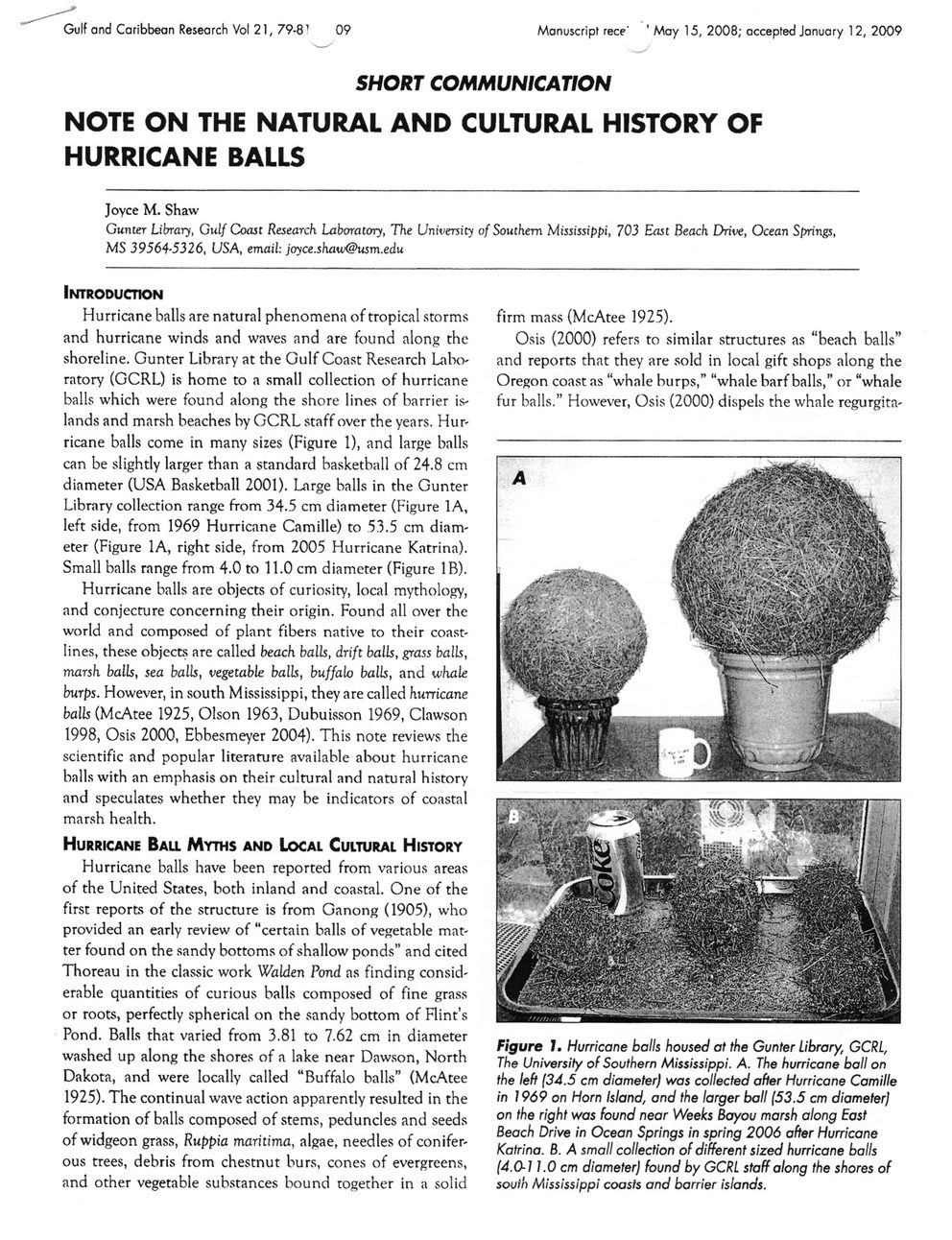This text was obtained via automated optical character recognition.
It has not been edited and may therefore contain several errors.
Gulf and Caribbean Research Vol 21, 79-81 09 Manuscript rece' ' May 15, 2008; accepted January 12, 2009 SHORT COMMUNICATION NOTE ON THE NATURAL AND CULTURAL HISTORY OF HURRICANE BALLS Joyce M. Shaw Gunter Library, Gulf Coast Research Laboratory, The University of Southern Mississippi, 703 East Beach Drive, Ocean Springs, MS 39564-5326, USA, email: joyce.shaw@usm.edu Introduction Hurricane balls are natural phenomena of tropical storms and hurricane winds and waves and are found along the shoreline. Gunter Library at the Gulf Coast Research Laboratory (GCRL) is home to a small collection of hurricane balls which were found along the shore lines of barrier islands and marsh beaches by GCRL staff over the years. Hurricane balls come in many sizes (Figure 1), and large balls can be slightly larger than a standard basketball of 24.8 cm diameter (USA Basketball 2001). Large balls in the Gunter Library collection range from 34.5 cm diameter (Figure 1A, left side, from 1969 Hurricane Camille) to 53.5 cm diameter (Figure 1A, right side, from 2005 Hurricane Katrina). Small balls range from 4.0 to 11.0 cm diameter (Figure IB). Hurricane balls are objects of curiosity, local mythology, and conjecture concerning their origin. Found all over the world and composed of plant fibers native to their coastlines, these objects are called beach balls, drift balls, grass balls, marsh balls, sea balls, vegetable balls, buffalo balls, and whale burps. However, in south Mississippi, they are called hurricane balls (McAtee 1925, Olson 1963, Dubuisson 1969, Clawson 1998, Osis 2000, Ebbesmeyer 2004). This note reviews the scientific and popular literature available about hurricane balls with an emphasis on their cultural and natural history and speculates whether they may be indicators of coastal marsh health. Hurricane Ball Myths and Local Cultural History Hurricane balls have been reported from various areas of the United States, both inland and coastal. One of the first reports of the structure is from Ganong (1905), who provided an early review of “certain balls of vegetable matter found on the sandy bottoms of shallow ponds” and cited Thoreau in the classic work Walden Pond as finding considerable quantities of curious balls composed of fine grass or roots, perfectly spherical on the sandy bottom of Hint’s Pond. Balls that varied from 3.81 to 7.62 cm in diameter washed up along the shores of a lake near Dawson, North Dakota, and were locally called “Buffalo balls” (McAtee 1925). The continual wave action apparently resulted in the formation of balls composed of stems, peduncles and seeds of widgeon grass, Ruppia maritima, algae, needles of coniferous trees, debris from chestnut burs, cones of evergreens, and other vegetable substances bound together in a solid firm mass (McAtee 1925). Osis (2000) refers to similar structures as “beach balls” and reports that they are sold in local gift shops along the Oregon coast as “whale burps," “whale barf balls,” or “whale fur balls.” However, Osis (2000) dispels the whale regurgita- Figure 7. Hurricane balls housed at the Gunter Library, GCRL, The University of Southern Mississippi. A. The hurricane ball on the left (34.5 cm diameter) was collected after Hurricane Camille in 1969 on Horn Island, and the larger ball (53.5 cm diameterj on the right was found near Weeks Bayou marsh along East Beach Drive in Ocean Springs in spring 2006 after Hurricane Katrina. B. A small collection of different sized hurricane balls (4.0-11.0 cm diameter) found by GCRL staff along the shores of south Mississippi coasts and barrier islands.

Hurricane Balls Gulf-and-Carribbean-Research-(1)